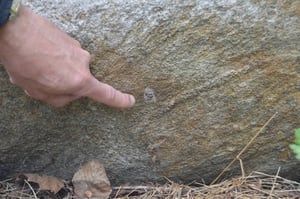Learn About Spotted Lanternflies
What are spotted lanternflies?
They show up every summer. For weeks on end, spotted lanternflies seem like they’re everywhere, and they’re not just annoying, they’re also a major threat to local agriculture, sweeping farms and destroying crops. The devastation expands throughout parks, neighborhoods, and maybe even your home.
The public needs to know about this invasive pest and what can be done to slow its spread. So, let’s talk about spotted lanternflies.
What do spotted lanternflies look like?
Spotted lanternflies have a different appearance at every stage of the life cycle.

Eggs: Found in masses of 30-50, eggs appear to be what some describe as splotches of mud or unevenly spread mortar. If you see a suspected egg mass, scrape it off into a bag or container and either submerge it in alcohol or hand sanitizer to kill them. Never leave spotted lanternfly egg masses alone. The easiest way to control them is to kill them before they hatch.

Nymphs: Once spotted lanternfly eggs hatch, they emerge in the nymph stage. They are black or red with whitepolka dots and roughly between ¼-½ inch long.
Once spotted lanternflies hatch from their eggs, they emerge in the nymph stage. They are black or red with white polka dots and roughly between ¼-½ inch long.

Adults: Adults are approximately 1” long and 1/2” wide at rest. The forewing is grey with black spots and the wing tips are reticulated black blocks outlined in grey. The hind wings have contrasting patches of red and black with a white band. The legs and head are black; the abdomen is yellow with broad black bands. Immature stages are black with white spots, and develop red patches as they grow.
Why are spotted lanternflies dangerous?
Spotted lanternflies are incredibly destructive and can cause damage quickly because of their habit of collecting in large numbers. They are a threat to trees, and they have the potential to decimate our regional farms.
Our region is also known for its breathtaking attractive state parks. Spotted lanternflies are an immediate threat to these parks and could easily continue expanding to other regions if they keep multiplying every year.
Finally, one more unpleasant thing about spotted lanternflies is the honeydew they leave behind. As spotted lanternflies feed on plant life, they secrete honeydew that can drench play sets and even decks.
Do spotted lanternflies bite?
No, spotted lanternflies don’t bite humans. They don’t pose any direct threats to the health of people or pets in terms of biting or spreading disease.
What do spotted lanternflies eat?
They feed on a large host of plants including fruit trees, vegetables, vines, and tree of heaven. If you have tree of heaven on your property, there is a significantly greater chance that spotted lanternflies will invade because it’s their primary food of choice.
Why are spotted lanternflies in New Jersey and Pennsylvania?
The spotted lanternfly is native to Asia, with the first confirmed infestation in the United States in Berks County, Pennsylvania in September 2014. They were likely introduced by stowing away in shipping crates as eggs, which are laid 30-50 at a time. They’ve grown to be an epidemic across Pennsylvania, threatening the lives of foliage, crops, and trees.
How do spotted lanternflies spread?
Spotted lanternflies spread in several ways. They can hitchhike in cars and open transportation like horse trailers and dog crates. When you park under a tree, you put yourself at increased risk of introducing spotted lanternflies whether from a window left cracked open, a door, or your trunk.
They are known to rest on the outside of cars, making it easy to unknowingly spread them.
What should I do if I find spotted lanternflies?
- Egg masses: Finding spotted lanternfly egg masses before they hatch is your best defense against infestations. If you spot egg masses, Penn State Extension recommends that you scrape them into a ziplock bag with the edge of a credit card and then pour rubbing alcohol in to effectively kill the unborn larvae.
- Adults and nymphs: If you find spotted lanternflies, squash them immediately. They are not known to bite, so you are not in any imminent danger when coming into contact with spotted lanternflies. Just squash them! Many municipalities even host squashing parties to make a bigger dent in the problem.
- Report the sighting: If you’re in Pennsylvania, report your sighting to the Pennsylvania Department of Agriculture.


